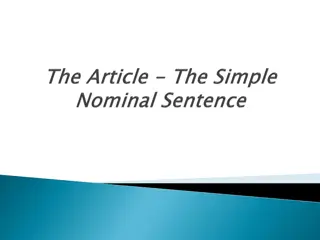Exploring Denotative Meaning and Translation Issues in Arabic Language
The article delves into denotative meaning, semantic repetition, synonym/near-synonym repetition, grammatical transposition, and semantic distancing techniques in Arabic language translation. It discusses how Arabic utilizes various forms of repetition and transposition that differ from English, showcasing examples and insights to enhance comprehension of translation challenges.
Download Presentation

Please find below an Image/Link to download the presentation.
The content on the website is provided AS IS for your information and personal use only. It may not be sold, licensed, or shared on other websites without obtaining consent from the author. Download presentation by click this link. If you encounter any issues during the download, it is possible that the publisher has removed the file from their server.
E N D
Presentation Transcript
Denotative meaning and translation issues By Mohammed I. Khalil Coures Touter: Prof. Ahmed Q. Abed
Semantic repetition in Arabic It is a repetition of meaning. This involves the use of two (or more) synonyms or near-synonyms but it can also be extended hyperonym-hyponym pairs and words and phrases standing in an associative relationship. to include
Synonym and near-synonym repetition Arabic frequently makes use of repetition of synonyms or near- synonyms in a way that is not normally found in English. We will refer to this repetition as (near-) synonym repetition which is two basic kinds:
(near-) synonym repetition words or phrases - fully synonymous or, at least in the context where they used - no clear difference in meaning two words or phrases - closely related but distinguishable investigation and analysis
Synonym and near-synonym repetition (Near-)synonym repetition may be syndetic (i.e. it may involve the use of a connective, typically ) or in the case of adjectives in particular, but also occasionally in the case of nouns and verbs it may be asyndetic (i.e. it may occur without the use of a connective). Example: behaviour . Another example is asyndetic doublets that are typically used to represent a single concept. savage and barbaric .
Synonym and near-synonym repetition The grammatical transposition: slightly claustrophobic , adverb adjective claustrophobic transposes the Arabic noun doublet ; following are examples of the man began to feel where the phrase slightly
Semantic Distancing Technique For example, in , words and are quite close in meaning, the phrase has been translated Her appearance had both astonished and alarmed him ; the semantic difference between astonish and alarm is greater than that between and . This semantic distancing ensures that the English translation does not involve what would otherwise be the stylistic oddity in English of having two words with virtually the same meaning conjoined with each other. the two
Hyperonym-hyponym repetition Not only synonyms and near-synonyms in Arabic are repeated in ways that are unusual in English, but it is also fairly common in Arabic for a hyperonym to be followed by its hyponym in a way that appears to an English speaker to result in a semantic anomaly.
Hyperonym-hyponym repetition .. ) ( ) ( This might be translated literally as: They don t talk to anyone, but they joke with the (sellers) and the (barrow- men).
Hyperonym-hyponym repetition Here, the sellers is a hyperonym of barrow-men (literally, travelling [people] but normally used to describe people who sell goods from a barrow or handcart); all barrow-men are sellers but not all sellers are barrow-men In cases such as this, the meaning of the first word in the particular context has to be taken as excluding that of the second word.
Associative repetition A third form of semantic repetition that is frequently found in Arabic but does not normally occur in English is what can be termed repetition. It involves at least two or more elements, one of which is a basic element and the other, or others, of which are associated with that element. associative
Associative repetition An example is ship and crew of a ship . Crew of a ship is not a type of ship (i.e. this is not a hyperonym- hyponym relationship); nor is it a part of a ship (as is a ship s mast, for example); this would be meronymic that is, part whole relationship
List restructuring One particularly striking feature in Arabic is a tendency to use fairly long lists of terms belonging to the same semantic field a semantic field being a general, normally impressionistically meaning (e.g. the semantic field of farm machinery, emotions or types of movement) rather area defined, of
: { } Like politicians, they insist upon all the outward trappings of privilege: bodyguards, and all the finery that money can buy. mansions, palaces, This translation omits specific translation of the later listed elements in the Arabic , utilizing instead the phrase all the finery which money can buy.























